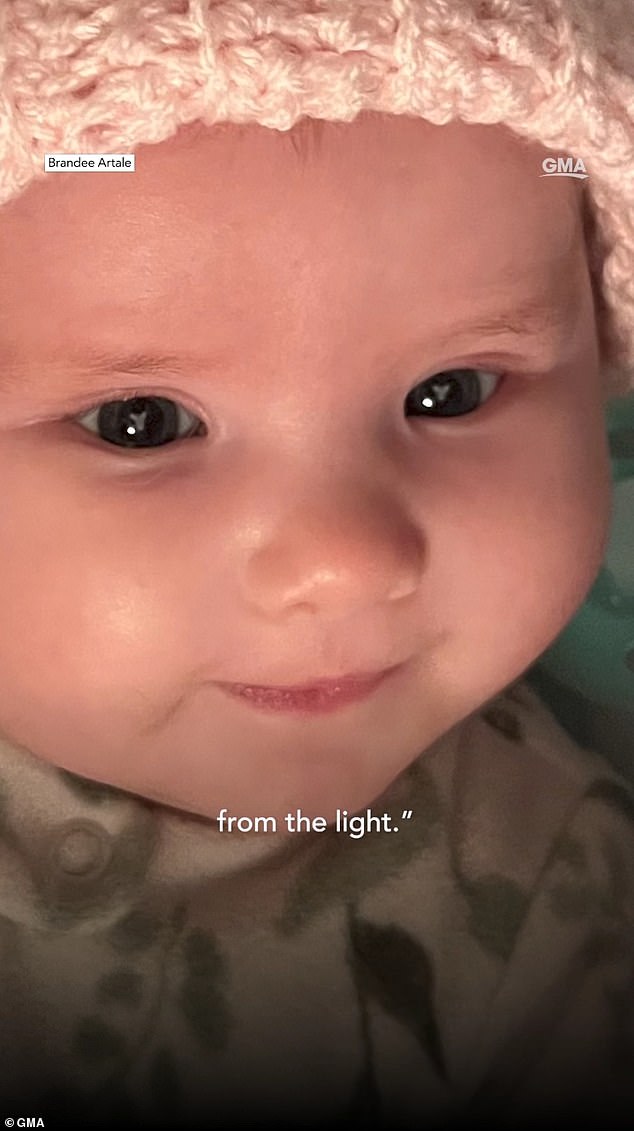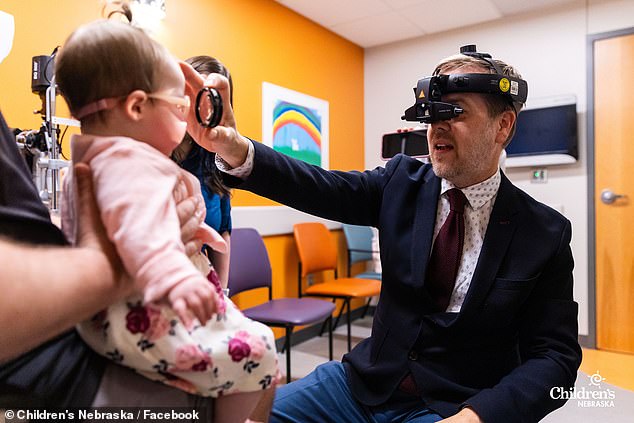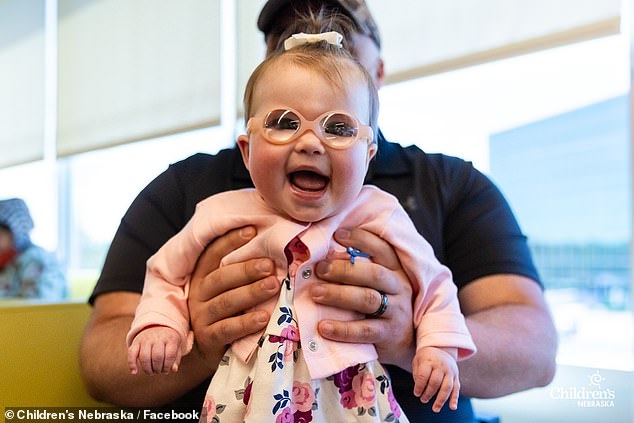Nebraska baby faces blindness due to geriatric vision problems that usually affect seniors
A Nebraska mother saved her daughter from going blind after noticing a barely visible abnormality in the child’s eye.
Brandee Artale noticed a strange clouding in her newborn’s eyes while breastfeeding and immediately knew something was wrong.
The family would later learn that this is a symptom of childhood cataracts, in which the eye becomes covered with an opaque lens.
If the condition is left untreated, babies can lose their place.
Brandee Artale (pictured) noticed that her newborn’s eyes were clouded, and it was determined that they had infant or congenital cataracts

Ms. Artale first noticed that her daughter’s eyes were cloudier than normal while she was breastfeeding
According to the American Academy of Ophthalmology, about three in 10,000 American babies are born with childhood cataracts, also called congenital cataracts.
The condition, which mainly affects older adults, causes the eye’s lens to lose its transparency, allowing less light to pass through, resulting in blurred vision. Over time, the clouding worsens until patients achieve total vision loss.
The cause of baby Madison’s cataract is unknown, although it often occurs due to genetic abnormalities.
Mrs. Artale told me Good morning America about the moment she noticed the condition: “I actually looked at her… and I thought, something just looks weird in her eyes.” It looked quite cloudy somehow.”
The Artales took their daughter to Dr. Paul Rychwalski, an ophthalmologist at Children’s Nebraska Hospital, who performed three surgeries over nine months in Madison, including two when she was a newborn, saving her sight.
Both operations had to be done before she turned six weeks old to remove the cloudiness above her eyes.
Dr. Rychwalski said, “The brain isn’t fully engaged for the first six weeks, so we have some flexibility, but after that the clock starts ticking.”
Increasing pressure in her eyes required a third surgery to correct the common side effect of cataract surgery.

The Artales took their daughter to Dr. Rychwalski (pictured) who performed three surgeries in Madison over nine months, including two when she was a newborn, which saved her sight.

Madison was finally able to get glasses, an opportunity that changed the life of the baby as well as that of her mother and father, Andrew (shown)
He added: ‘There is a very good chance that if we keep a close eye on her she will have better than 20/40 vision in each eye.
“But many obstacles can arise, so this family will be a very close part of our family at Children’s Nebraska for years to come to ensure she doesn’t have any complications down the line.”
Madison was finally able to get glasses, an opportunity that changed the life of the baby as well as that of her mother and father, Andrew.
She is cranky when she has to take them off and looks for them as soon as she wakes up.
Ms Artale said: “She fought it at first and then she could finally see things. She looked at me like, ‘Mom, I see you,’ and I was just bawling.” ‘
You can definitely see her taking it all in.”
Mr. Artale added, “Many parents initially say to me, ‘My child won’t wear glasses,’ and my response is, ‘Well, just wait and see.’
“If the child is shown what real, focused vision is like, they will quickly get used to it.”
Her prognosis was very good, thanks to her mother’s ability to notice the unusual quality of her daughter’s vision.
The Artales now want to raise awareness of their daughter’s condition in the hope that parents can avoid the risk of blindness in their babies.
Dr. Rychwalski reiterated their mission, saying the most important thing is that parents feel empowered to bring up the abnormality with their child’s doctor. And parents can pay attention to how their baby looks in photos.
He said: ‘It is normal (in photographs) to have this red reflex, or ‘red eye’, and if we have one side that is red and one side that is white, that could indicate something blocking the light in blocks the eye.
“If you ever see an abnormal red reflex or a white pupil, you’ll want to talk to your pediatrician or ophthalmologist about it right away.”
